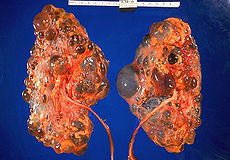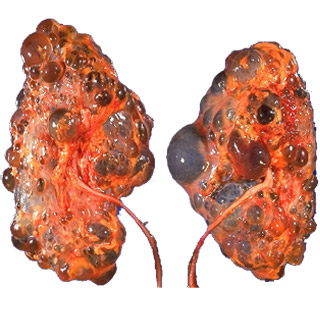Have you been lately suffering from an enlarged abdomen, flank pain and excessive urination at night? Know all about Polycystic Kidney Disease, a condition you are probably suffering from, and get informed about its various causes, symptoms, treatment options and prognosis.
What is Polycystic kidney disease?
Page Contents
- 1 What is Polycystic kidney disease?
- 2 Polycystic kidney disease Incidence
- 3 Polycystic kidney disease Types
- 4 Polycystic kidney disease ICD9 Code
- 5 Polycystic kidney disease Symptoms
- 6 Polycystic kidney disease Causes
- 7 Polycystic kidney disease Diagnosis
- 8 Polycystic kidney disease Complications
- 9 Polycystic kidney disease Prevention
- 10 Polycystic kidney disease Treatment
- 11 Polycystic kidney disease Prognosis
- 12 Polycystic kidney disease Life Expectancy
- 13 Polycystic kidney disease Support Groups
- 14 Polycystic kidney disease Pictures
Polycystic kidney disease (PKD) is a genetic condition of the kidney characterized by the formation of a number of cysts in the organ, resulting in its inflammation.
The disorder has also been given the name Autosomal dominant polycystic kidney disease (ADPKD).
Polycystic kidney disease Incidence
The disease reportedly affects about one out of every one thousand Americans. However, the actual statistics can be higher as many ADPKD patients are found to be asymptomatic. The condition goes unreported as such individuals do not experience any visible symptoms of the condition.
Polycystic kidney disease Types
The condition has been classified into two types:
Autosomal Dominant Polycystic kidney disease (ADPKD)
The signs of this type of PKD frequently develop between 30 and 40 years of age. The condition mainly affects adults, due to which this form of the disease was earlier referred to as Adult Polycystic kidney disease. However, the condition can also affect children and is referred to as Infantile Polycystic kidney disease in such cases.
Autosomal Recessive Polycystic kidney disease (ARPKD)
This form is far less common than ADPKD. Its signs usually arise shortly after birth. In some cases, the symptoms do not develop until during the later stages of childhood or at the time of adolescence.
Polycystic kidney disease ICD9 Code
The ICD9 Code of the condition is 753.1.
Polycystic kidney disease Symptoms
As aforesaid, the disease is marked by the development of numerous cysts within the kidney. Cysts are the benign round sacs consisting of watery fluid. Although kidneys are the organs most affected by PKD, the condition can impact several other regions of the body as well – such as the liver.
The condition usually gives rise to the following signs and symptoms:
- Pain in one or both flanks (side between hipbone and ribs)
- Too much urine output at night
- High blood pressure
- Blood in urine
- Pain in the back
- Headaches
- Tenderness or pain in the abdomen
- Enlargement of the abdomen
- Kidney stones
- Kidney failure
- Infections in the kidney or the urinary tract
Other symptoms that might arise along with the aforementioned signs include:
- Joint pain
- Drowsiness
- Nail abnormalities
It is not unlikely for PKD patients to silently suffer from the disease for many years without developing any symptoms of the condition and not even knowing that they have the disorder.
Polycystic kidney disease Causes
This is an inherited condition and generally has an autosomal dominant trait. Children have a 50% risk of acquiring the disease if even one parent is a carrier of the gene responsible for this syndrome. People suffering from the condition are found to have clusters of cysts in their kidneys. It is not known what exactly triggers the development of these cysts.
Causes of ADPKD
Children are at risk of getting this disease even if only one parent is a carrier of the condition. A child has a 50% risk of getting the disorder with only one ADPKD patient. This type accounts for around 90% of all cases of PKD.
Causes of ARPKD
Children are at risk of getting the disease only when both parents carry the abnormal genes responsible for the disorder. Each child stands at a 25% risk of suffering from the condition when both parents carry a gene that results in this disease.
However, a person can also have ADPKD even when there are no immediate family members with the disease. In such cases, a family member of the sufferer might have had this disease but was asymptomatic. In rare cases without a family history being responsible, a spontaneous genetic mutation might be the actual cause of the disorder.
Polycystic kidney disease Diagnosis
Various diagnostic methods can be used to determine the number as well as the size of cysts within the kidney as also to assess the amount of healthy tissue inside the organ. The tests include:
Computerized Tomography (CT) Scan
This exam involves placing patients on a movable table and guiding them into a chamber that projects X-rays beams through their body. The test allows physicians to view cross-sectional images of the kidneys.
Magnetic Resonance Imaging (MRI) Scan
Patients are made to lie inside a large cylindrical chamber. Radio waves and magnetic fields are used to generate cross-sectional views of the kidneys.
Ultrasound examination
This is a common diagnostic imaging procedure in which a wand-like device (known as a transducer) is placed over the body. The equipment emits inaudible audio waves that are reflected back to it, in a process similar to sonar. The reflected audio waves are transmitted to a computer that shows the images of the kidneys on its monitor screen.
Polycystic kidney disease Complications
The major complications associated with PKD include:
High blood pressure
It is one of the most common complications of PKD. If left untreated, elevated blood pressure can increase the risk of stroke and heart disease as also cause greater damage to the kidneys.
Kidney failure
It is another serious problem associated to this disorder. Progressive loss of kidney function is a highly dreaded symptom of PKD. The kidneys gradually become incapable of eliminating wastes from the body and maintaining the balance of chemicals and fluids.
Around half of all PKD patients are affected by kidney failure by the time they are 60 years old. Patients having protein or blood in urine, or having high blood pressure, are at a higher risk of suffering a kidney failure.
Some other complications associated with PKD include:
- Kidney stones
- Recurring urinary tract infections
- End-stage kidney disease
- Chronic kidney disease
- Bleeding or ruptured cysts
- Mild to severe liver failure
- Infection of liver cysts
However, the severity of PKD tends to vary to a great extent. Fortunately, some of the complications can also be prevented.
Polycystic kidney disease Prevention
At present, there is no preventive measure to check the development or enlargement of cysts within the kidney or any other organ of PKD patients. However, sufferers can follow certain measures to keep their kidneys healthy and prevent some of the complications associated to this disorder. Management of high blood pressure is one of the most important ways to protect the health of the kidneys. This can be done by adapting the following measures:
- Sticking to a low-salt diet, comprising of lots of whole grains, vegetables and fruits
- Taking medications for controlling blood-pressure, as prescribed and directed by physician
- Giving up smoking, if you are a habitual smoker
- Maintaining a proper body weight (after consulting a doctor about what the ideal body weight should be)
- Exercising on a regular basis; at least half-an-hour of workouts comprising of moderate physical activities on most days of the week
Polycystic kidney disease Treatment
The treatment of the condition involves symptomatic cure, i.e., curing its various symptoms and complications such as:
Kidney failure
Patients need a kidney transplant or a dialysis if their own kidneys lose the ability to perform vital functions like removal of wastes and additional fluids from the bloodstream.
High blood pressure
Proper management of high blood pressure may retard the rate of progression of PKD and slow down the damage of kidneys further. Not smoking, sticking to a low-calorie, low-salt diet, reducing stress and increasing level of regular exercise may be beneficial in controlling the level of blood pressure.
Infections of kidney or bladder
Prompt use of antibiotics can be necessary to prevent damage to the kidneys.
Pain
One of the commonest symptoms of kidney disease is chronic pain, generally originating in the side or the back. The aches are often mild and can be controlled with over-the-counter analgesics such as acetaminophen. The pain is more constant and severe in some sufferers. In rare cases, where cysts are large enough to cause pain and pressure, physicians may recommend a surgical removal.
Cysts
In certain cases of kidney cysts, physicians recommend a surgical drainage or complete removal of the vesicles. In case of liver cysts, non-surgical management involves avoiding hormone replacement therapy. In rare cases, other options involve draining symptomatic cysts if they are not too many in number.
Polycystic kidney disease Prognosis
The condition does not have a very good outcome. The disorder slowly tends to get worse and eventually results in an end-stage kidney failure. PKD is also associated with liver disease, including infection of cysts developing within the liver. Fortunately, patients may experience relief from symptoms for many years with the help of medical treatment. Individuals affected by PKD, who do not suffer from other disorders, may gain benefits from a kidney transplant.
Polycystic kidney disease Life Expectancy
The life expectancy of the disorder depends on the severity of ailment as well as the disorders, treatment measures and management options adapted for curing the condition. For males in the U.S, the average life expectancy is 75 years.
Polycystic kidney disease Support Groups
PKD patients and their family members can get in touch with various organizations for support and necessary guidance to cope with the disorder. If you have the disease, you can get in touch with the Polycystic kidney disease Foundation. The address and contact details of the organization have been given below:
Polycystic kidney Disease Foundation
9221 Ward Parkway, Suite 400
Kansas City, MO 64114-3367
Phone: 1-800-PKD-CURE (753-2873) or 816-931-2600
Email: [email protected]
Internet: www.pkdcure.org
Some other helpful organizations are:
National Kidney Foundation
30 East 33rd Street
New York, NY 10016
Phone: 1-800-622-9010 or 212-889-2210
Internet: www.kidney.org
American Association of Kidney Patients
3505 East Frontage Road, Suite 315
Tampa, FL 33607
Phone: 1-800-749-2257 or 813-636-8100
Email: [email protected]
Internet: www.aakp.org
Kidney Health Australia Information Line
Tel. 1800 4 KIDNEY (543 639)
The National Renal Resource Centre
Tel. (02) 9362 3995 or 1800 257 189
Polycystic kidney disease Pictures
Take a look at these images to know how kidneys affected by PKD appear to view.

Picture 1 – Polycystic kidney disease
Picture 2 – Polycystic kidney disease Image
People experiencing at least some of the symptoms of PKD should immediately get in touch with a physician to know about the underllying cause of the problems. Those having a first degree relative, such as a sibling, child or parent affected by the disorder should consult a doctor to understand the advantages and disadvantages of screening for the condition.
References:
http://www.ncbi.nlm.nih.gov/pubmedhealth/PMH0001531/
http://www.mayoclinic.com/health/polycystic-kidney-disease/DS00245
http://www.patient.co.uk/health/polycystic-kidney-disease
http://emedicine.medscape.com/article/244907-overview

